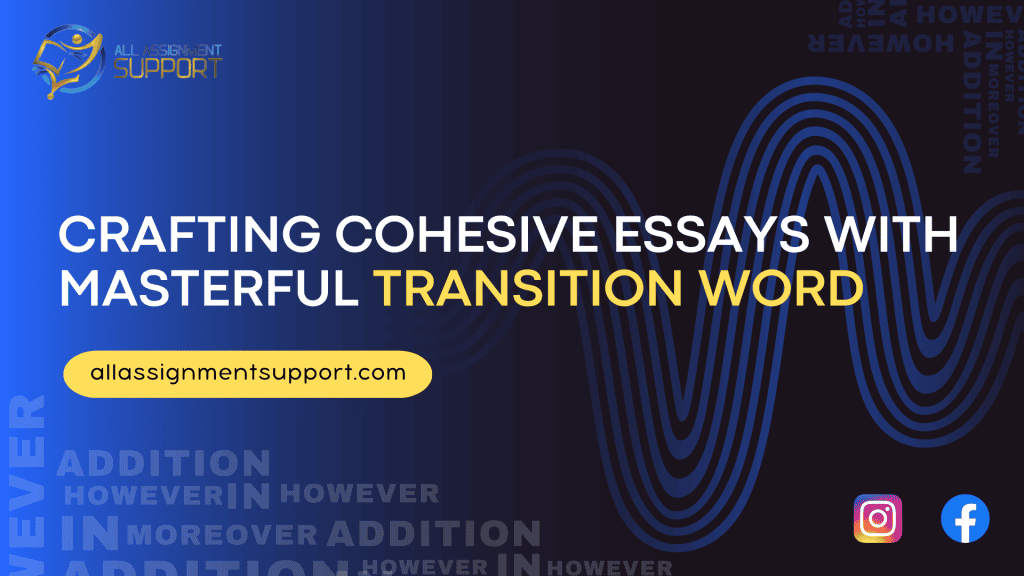Table of Contents
ToggleIntroduction
Transition words are the unsung heroes of proficient essay writing, discreetly guiding readers through complex ideas and enhancing the clarity of your work. These unassuming connectors are vital for seamlessly linking paragraphs, allowing readers to navigate your essay effortlessly. This article is a comprehensive exploration of transition words for essays.
We’ll explore their various types, understanding how each enriches essay composition. We’ll demystify their strategic use, ensuring your essays communicate effectively and flow naturally. Join us to learn the art of linguistic finesse and logical elegance as we uncover the key to crafting engaging essays through the power of transition words.
Introduction to Transition Words and Their Importance in Essays
In this segment, let us discover how transitioning words play their effective role in the field of essay writing. We will also take a sneak peek into how these transition words play their role in mind boggling essays. Helping you get started here:
Definition of Transition Words
Transition words, or linking or connecting words, are linguistic tools that bridge the gap between sentences, paragraphs, and ideas. They act as signposts, guiding readers through the logical progression of your arguments and helping to establish relationships between different parts of your essay. Paragraph transition words play a pivotal role while compelling pieces are formulated.
Role of Transition Words in Essay Writing
Transition words serve as the glue that binds your essay together. They ensure a smooth flow of ideas, allowing readers to follow your thought process without confusion. By connecting sentences and paragraphs, transition words facilitate the development of a clear and organized narrative, making your essay more engaging and understandable.
Importance of Smooth Paragraph Transitions
Smooth transitions between paragraphs are essential for maintaining the rhythm and coherence of your essay. Transition words enable you to transition seamlessly from one point to another, creating a natural and logical progression of ideas. Effective transitions make your writing feel cohesive and easier to follow, diminishing its overall impact.
Transition words are not just a stylistic choice but a fundamental tool that elevates your writing from a collection of sentences to a coherent and compelling essay. Let’s understand transition words better and harness their power to craft exceptional essays. In a nutshell, paragraph transition words play a significant role in helping readers navigate through your content in a streamlined manner.
Types of Transition Words
Here are the different types of transition words you can go for. Helping you get started with respect to the same:
A. Sequential Transitions
As the name suggests, sequential transitions indicate the order or sequence of events, ideas, or points in your essay. They provide a roadmap for readers, helping them navigate your content step-by-step. Sequential transitions are beneficial when presenting a series of related topics, outlining processes, or discussing historical developments.
Examples of sequential transitions
These transition words are commonly used to introduce a sequence of ideas or events. “Firstly” and “first of all” mark the initiation of a series, followed by “secondly,” “next,” and “thirdly,” which guide the reader through subsequent points. Finally, “lastly” or “finally” signal the sequence’s conclusion. Other variations like “in addition,” “furthermore,” and “moreover” can also be employed to introduce additional points within the sequence.
How Sequential Transitions Improve Readability and Coherence?
Sequential transitions enhance the clarity of your writing by outlining the logical progression of your ideas. They prevent confusion by providing a clear order for readers to follow. When used effectively, these transitions create a structured framework, making your essay easier to comprehend. They aid in building a sense of flow and unity, preventing your essay from feeling disjointed.
Incorporating sequential transitions not only organizes your thoughts but also allows readers to anticipate what comes next. This anticipation fosters engagement as readers are guided through your content with an understanding of the underlying structure.
B. Causal Transitions
Let us have a deeper understanding on what casual transition words are. Examples and case studies have been provided to you via the underlying paragraphs. Helping you get
Explanation of Causal Transitions
Causal transitions are vital in establishing cause-and-effect relationships between ideas or events in your essay. They elucidate why something happened, providing readers with insight into the connections between different aspects of your content. Causal transitions are beneficial when presenting arguments, explaining consequences, or analyzing the impacts of specific actions or occurrences.
Examples with respect to the same
Causal transitions introduce a cause-and-effect relationship. “Because” and “since” indicate the reason behind an event or claim, while “as a result” and “therefore” underscore the consequences or outcomes. Other expressions like “due to,” “owing to,” and “resulting from” also establish causal connections between elements in your essay.
How Causal Transitions Enhance Logical Flow in Essays
By incorporating causal transitions, you strengthen the logical coherence of your writing. They provide a framework that supports the progression of your arguments, helping readers understand the underlying logic behind your points. Causal transitions guide readers through the chain of reasoning, making your essay more persuasive and compelling.
Transparent cause-and-effect relationships established through these transitions empower readers to comprehend the implications of your ideas. The use of causal changes facilitates a smooth reading experience, as it minimizes the need for readers to infer connections on their own. This enhances both the persuasiveness of your arguments and the overall clarity of your essay.
C. Comparative Transitions
Comparative transitions are the bridges that help readers navigate the similarities and differences between ideas, concepts, or viewpoints in your essay. They enable you to draw comparisons and contrasts, enhancing your essay’s depth and breadth. Comparative transitions are particularly effective when analyzing multiple perspectives, discussing opposing viewpoints or illustrating similarities and differences.
Examples pertaining to how comparative transitions work
Comparative transitions introduce comparisons and contrasts. “Similarly” and “likewise” highlight similarities between ideas, while “in contrast” and “on the other hand” emphasize differences. Other expressions like “by comparison”, “in a similar vein”, and “conversely” further establish connections and contrasts in your essay.
How Comparative Transitions Help Establish Connections and Contrasts?
Comparative transitions facilitate a nuanced understanding of your essay’s content by framing it with other ideas. They guide readers through complex discussions by signaling when you’re introducing a similar idea or presenting a contrasting viewpoint. These transitions ensure readers can readily discern the relationships between your concepts, ultimately contributing to a more insightful and balanced essay.
Using comparative transitions, you avoid abrupt shifts in tone or subject matter, maintaining a steady flow that keeps readers engaged. Whether you’re highlighting parallels or addressing differences, these transitions provide a roadmap for readers to navigate the intricacies of your essay’s content.
D. Adversative Transitions
Adversative transitions serve as the tools that help you acknowledge opposing viewpoints, introduce contrasts, and navigate through conflicting ideas in your essay. These transitions ensure that your writing is well-rounded and accounts for various perspectives, making it more persuasive and comprehensive. Adversative changes are precious when addressing counterarguments, presenting differing viewpoints, or highlighting limitations.
Examples for adversative transitions
Adversative transitions introduce contrasts and conflicting ideas. “However” and “nevertheless” indicate a shift in direction, while “although” and “even though” present a contrasting viewpoint. Other expressions like “on the contrary,” “despite this,” and “in spite of that” further emphasize the adversarial relationship between ideas.
How Adversative Transitions Address Counterarguments and Differing Viewpoints
Adversative transitions provide a platform for you to engage with opposing perspectives in a respectful and structured manner. By acknowledging differing viewpoints, you demonstrate intellectual rigor and credibility, allowing your readers to see the complexity of the topic. These transitions also help you maintain a balanced tone, showing you’ve thoroughly considered multiple sides of the issue.
Incorporating adversative transitions allows you to address potential counterarguments or doubts preemptively readers might have. This proactive approach helps you build a stronger case for your viewpoint while showing that you’ve taken the time to consider alternative interpretations. Transition words for body paragraphs are also needed to promote content more smoothly.
E. Illustrative Transitions
Illustrative transitions are the tools that enable you to provide evidence, offer examples, and clarify your points in an essay. These transitions enrich your writing by making it more tangible and relatable to your readers. Illustrative transitions are particularly valuable when you’re explaining complex ideas, supporting arguments with concrete evidence, or making your content more accessible.
Examples of Illustrative transitions
Illustrative transitions introduce specific instances or explanations. “For example” and “to illustrate” present concrete cases that demonstrate your point, while “in other words” and “specifically” offer alternative explanations or details. Other expressions like “such as”, “namely”, and “in particular” further elaborate on your ideas.
How Illustrative Transitions Provide Evidence and Clarifications?
Illustrative transitions serve as signposts that guide your readers through the supporting details that validate your claims. By using these transitions, you enhance the persuasiveness of your arguments, grounding them in real-world examples or clear explanations. This makes your essay more relatable and understandable to a broader audience.
These transitions also help you convey complex concepts in a more digestible manner. They break down intricate ideas into smaller, more understandable pieces, ensuring that your readers can follow your train of thought. Illustrative transitions ultimately strengthen your essay’s impact, making it more persuasive.
F. Emphasizing Transitions
Emphasizing transitions are the tools that help you highlight key points, reinforce important ideas, and underscore the significance of certain aspects of your essay. These transitions add weight and depth to your writing, guiding readers to focus on critical elements. Emphasizing transitions is particularly valuable when you want to draw attention to pivotal arguments, essential concepts, or noteworthy details. Similarly, transition words used for body paragraphs help readers decipher the crux of the subject matter in a more compelling manner.
Examples of emphasizing transitions
Emphasizing transitions introduces statements that underscore the importance of what you’re discussing. “Indeed” emphasizes a point’s truth or validity, while “above all” signals the utmost importance. “Notably” draws attention to a specific detail, and “certainly” indicates a strong assurance. Other expressions like “in fact”, “without a doubt”, and “unquestionably” further amplify your assertions.
How Emphasizing Transitions Highlights Key Points and Ideas?
Emphasizing transitions injects authority and impact into your essay. By using these transitions, you guide readers toward the crux of your argument or the heart of your narrative. They signal that a particular point deserves special consideration, encouraging readers to pay closer attention to the information you’re presenting.
These transitions also contribute to the overall rhythm of your essay. By strategically placing them, you can create a natural ebb and flow that keeps readers engaged and intrigued. The use of good transition words for essays elevates your essay’s persuasiveness and readability, making it more compelling and memorable.
Read Also: Argumentative Essay Topics
Effective Usage of Transition Words in Essays
Transition words are the adhesive that holds an essay together, transforming a collection of ideas into a coherent and flowing narrative. In this section, we will delve into the art of using good transition words for essays effectively, ensuring that your writing is both engaging and intelligible.
A. Guidelines for Proper Transition Word Usage
To employ transition words successfully, consider these guidelines:
- Choose transition words that suit the relationship between ideas (e.g., causal, comparative, sequential).
- Place transition words strategically to maintain the logical flow of your essay.
- Use transitions to connect sentences within a paragraph and paragraphs within your essay.
B. Avoiding Overuse and Redundancy
While transition words enhance readability, overusing them can lead to redundancy. Avoid using the same transition repeatedly within a short span. Instead, vary your choices to keep your writing dynamic and engaging. Alternatively, the correct usage of transition words in paragraphs emphasize the story of your content in a vibrant and visible manner.
C. Balancing Variety and Coherence
Strike a balance between using a variety of transition words and maintaining the overall coherence of your essay. Too many transitions can make your writing appear cluttered, while too few may result in disjointed ideas. Aim for a seamless balance that guides readers without overwhelming them. In a nutshell, use the right kind of transition words in paragraphs and statements to create a wow effect on the minds of readers who go through the content.
D. Tips for Seamless Incorporation of Transitions
1. Transitional Phrases
Use phrases like “as a result”, “on the other hand”, and “in addition” to seamlessly introduce transition words within sentences.
2. Parallel Structure
Ensure that the structure of sentences before and after the transition remains consistent, enhancing the overall flow.
3. Contextual Relevance
Choose transitions that align with the context and purpose of your essay, enhancing the clarity of your arguments.
4. Editing and Revising
After writing, review your essay specifically for transition word placement. Make adjustments to improve coherence and readability.
Mastering the art of using transition words enhances your essay’s clarity, ensuring that readers can effortlessly navigate your ideas.
Transition Words and Paragraph Structure
Transition words are the architects of paragraph structure, guiding readers through your essay’s content with finesse and clarity. This section will explore how transition words play a crucial role in shaping strong and well-organized paragraphs. Transition words for essays set the right tone for readers who go through authentic and well-formulated content as a matter of fact.
A. How Transition Words Contribute to Strong Paragraph Structure?
Transition words serve as the invisible scaffolding that upholds the structure of your paragraphs. They establish relationships between sentences, ensuring a seamless progression of ideas. These words are the secret to maintaining the coherence that keeps readers engaged and your writing impactful.
B. Connecting Ideas Within a Paragraph Using Transitions
Transition words help connect ideas within a paragraph, emphasizing their logical relationship. Words like “furthermore,” “moreover,” and “in addition” demonstrate the expansion of an idea. “However,” “on the other hand,” and “nonetheless” reveal contrasting viewpoints. By skillfully weaving these transitions, you create a tapestry of thoughts that resonates with readers.
C. Using Transition Words for Topic Sentences and Concluding Sentences
Transition words serve as vital components of topic sentences, introducing the central idea of a paragraph. They signal to readers your upcoming focus and contribute to the unity of your essay. Similarly, in concluding sentences, transition words like “in conclusion”, “to summarize”, and “as a result” provide a satisfying wrap-up, solidifying the paragraph’s key message.
D. Examples of Well-Structured Paragraphs with Transition Words
● Example 1:
Topic Sentence: Modern technology has revolutionized communication.
Transition: Furthermore, smartphones and social media platforms have played a pivotal role in this transformation.
Supporting Details…
Concluding Sentence: In conclusion, the impact of technology on communication is undeniable.
● Example 2:
Topic Sentence: Environmental conservation requires collective effort.
Transition: On the other hand, individual actions can have a significant impact on the planet’s well-being.
Supporting Details…
Concluding Sentence: Therefore, every small effort counts in the larger mission of preserving our environment.
Mastering the art of transitioning within paragraphs adds depth and coherence to your writing.
Transition Words and Essay Flow
Transition words are the navigational tools that guide readers through the currents of your essay, ensuring a seamless journey from start to finish. In this section, we will explore how these words contribute to the overall flow of your essay, enhancing its readability and impact.
A. How Transition Words Contribute to Overall Essay Flow
Transition words are the threads that weave the fabric of your essay together. They bridge the gaps between ideas, allowing readers to move effortlessly between paragraphs, sections, and concepts. These transitions enhance the rhythm of your essay, making it more engaging and digestible.
B. Crafting Smooth Transitions Between Paragraphs and Sections
Effective transition words enable you to transition smoothly from one paragraph to the next and from one section to another. Words like “meanwhile”, “in contrast”, and “similarly” establish connections that prevent abrupt shifts in tone or subject matter. This cohesion helps readers maintain their focus and momentum as they read.
C. Ensuring the Logical Progression of Ideas with Transition Words
Transition words provide the roadmap that leads readers through the logical progression of your ideas. Words like “therefore”, “consequently”, and “as a result” signal cause-and-effect relationships, reinforcing the sense that your essay is a well-structured argument rather than a series of disjointed points.
D. Techniques to Review and Improve Essay Flow Using Transition Words
Here are few enticing techniques on how you improve the flow of your essay content using transitional words. Helping you get started with the same:
1. Read Aloud
Reading your essay aloud helps identify awkward transitions and areas where the flow is disrupted.
2. Transitional Phrases
Incorporate transitional phrases at the beginning or end of paragraphs to clarify connections.
3. Reverse Outline
Create a reverse outline of your essay to assess how each paragraph contributes to the overall flow.
4. Peer Review
Seek feedback from peers or mentors to identify areas where transitions could be smoother.
Common Mistakes to Avoid When Using Transition Words
Transition words are a double-edged sword – while they can elevate your writing, improper usage can lead to confusion and disruption. In this section, we’ll address common pitfalls and provide strategies to sidestep them, ensuring your transition words enhance rather than hinder your essay.
A. Misusing Transition Words or Phrases
Misusing transition words, such as choosing a transition that doesn’t accurately reflect the relationship between ideas, can result in miscommunication. Always select transitions that align with the context and logic of your content.
B. Overloading Paragraphs with Too Many Transitions
Excessive use of transition words can overwhelm readers, obstructing the natural flow of your essay. Avoid using transitions in every sentence; instead, focus on using them strategically to guide readers through major shifts in thought.
C. Ignoring the Context and Purpose of Transitions
Neglecting the context and purpose of transitions can lead to jarring shifts or inappropriate connections between ideas. Ensure each transition serves a specific purpose and connects logically with the preceding and following content.
D. Strategies for Identifying and Rectifying Mistakes
Here are few authentic strategies experts use with respect to identifying and rectifying mistakes through content creation. Helping you get an understanding on the steps involved pertaining to the same:
1. Self-Review
After writing, read your essay with a critical eye, specifically for transition usage. Look for instances where transitions seem out of place or unclear.
2. Peer Review
Seek feedback from others to identify any transition-related issues that might be overlooked.
3. Consult Style Guides
Refer to style guides or writing resources to ensure you’re using transitions correctly and effectively.
4. Read Aloud
Reading your essay aloud helps identify awkward or confusing transitions that disrupt the natural flow.
By being mindful of these pitfalls and employing strategies to address them, you can refine your use of transition words and elevate the quality of your writing.
Transition Words for Different Types of Essays
Transition words are versatile tools that adapt to the unique demands of various essay types. In this section, we’ll delve into how to use transition words effectively across different genres, from argumentative and expository to narrative and persuasive essays.
A. Applying Transition Words to Argumentative Essays
In argumentative essays, transition words help you navigate the battleground of ideas. Phrases like “on the contrary”, “however”, and “in contrast” can signal counterarguments, while “more importantly”, “in light of this”, and “for these reasons” reinforce your position. Transition words establish a logical progression of evidence, reinforcing the persuasiveness of your arguments.
B. Using Transitions in Expository Essays
Expository essays demand clear and concise explanations. Transition words like “for instance”, “to clarify”, and “in other words” enable you to unpack complex concepts. “As a result”, “therefore”, and “consequently” underscore the cause-and-effect relationships that underpin your explanations, making your expository essay more comprehensible.
C. Incorporating Transitions into Narrative Essays
Narrative essays thrive on vivid storytelling. Transition words lend a helping hand in crafting a seamless narrative journey. Phrases like “meanwhile”, “later”, and “soon after” establish temporal order, while “in that moment”, “with bated breath”, and “at last” infuse your narrative with sensory details, drawing readers into the story.
D. Transition Words for Persuasive and Descriptive Essays
Persuasive essays require strategic persuasion, and transition words play a key role. “Undoubtedly”, “certainly”, and “without a doubt” lend authority to your claims, while “imagine”, “visualize”, and “picture this” help readers connect emotionally. In descriptive essays, transition words like “beyond”, “beneath”, and “above” guide readers through the landscapes you paint with words.
Exercises and Practice
Transition words are best mastered through practice. In this section, we present exercises designed to reinforce your understanding and application of these essential tools in writing.
A. Sentences with Missing Transitions for Practice
Below are sentences with missing transitions. Choose the most appropriate transition word from the list to complete each sentence.
- The research indicates a strong link between regular exercise and improved health __________ smoking cessation. Options: (however, in addition, consequently, similarly)
A: consequently
- The novel’s protagonist faced numerous challenges; __________, she never lost her determination to succeed. Options: (nevertheless, in conclusion, notably, on the contrary)
A: nevertheless
- The economic downturn affected many industries; __________, the tech sector experienced significant growth. Options: (in contrast, therefore, moreover, for instance)
A: in contrast
B. Rewriting Paragraphs with Improved Transition Word Usage
Revise the following paragraph by incorporating appropriate transition words to enhance its flow and coherence.
- Original Paragraph: The advantages of renewable energy sources are clear. Solar power and wind power are eco-friendly options. They produce no greenhouse gases. They contribute to reducing our carbon footprint.
- Revised Paragraph (with transition words): The advantages of renewable energy sources are evident. Moreover, solar power and wind power serve as eco-friendly options. In addition, they produce no greenhouse gases, thus contributing to the reduction of our carbon footprint.
C. Self-Assessment Questions to Reinforce Learning
- What is the role of transition words in maintaining the coherence of an essay?
- Which transition words are best suited for introducing examples?
- How can excessive use of transition words hinder the flow of your writing?
- Provide an example of a transition word that can be used to signal a cause-and-effect relationship.
- How can transition words be useful in narrative essays?
These exercises are designed to strengthen your familiarity with transition words and their applications. Engaging in practical exercises is a valuable step towards mastering the art of using these transitions to enhance the quality of your writing.
Conclusion
Transition words, often unnoticed but profoundly influential, are the linchpins of essay structure and readability.
As we wrap up, the key role of transition words is to guide readers through your thoughts. Transition words aren’t mere connectors; they weave an intricate fabric of ideas, seamlessly transitioning from one paragraph to another.
Their magic lies in clarity, improved readability, and logical flow. Transition words are your writing allies, elevating your essays beyond information to engaging narratives. So, refine your technique, and watch your essays become a symphony of words guided by the artistry of transition.
Frequently Asked Questions (FAQ’s)
1. Can I use transition words at the beginning of a sentence?
Yes, you can use transition words at the beginning of a sentence to signal a shift in focus or introduce a new idea. For instance, “Furthermore, the study revealed significant findings”.
2. Are there transition words specific to academic essays or formal writing?
While many transition words are versatile and can be used in various contexts, some, like “thus”, “hence”, and “therefore”, are more common in formal or academic writing.
3. How do I transition between paragraphs that discuss similar ideas?
When transitioning between paragraphs with similar ideas, use transition words like “likewise”, “similarly”, “in the same vein”, or “equally important” to maintain coherence.
4. What’s the difference between transition words and phrases?
Transition words are individual words that link sentences and paragraphs, while transition phrases are a group of words that perform the same function. For example, “for instance” is a transition phrase.
5. Can transition words be used in speech or only in writing?
Transition words are valuable in both speech and writing. They help guide listeners or readers through your thoughts, ensuring clarity and coherence.
6. What should I do if I can’t find a suitable transition word for a particular context?
If you can’t find a direct transition word, consider rephrasing the sentence or using a synonym that fits the context better. Sometimes, a well-structured sentence may not require a transition word.
7. How do transition words differ from conjunctions like “but”, “and”, and “or”?
Conjunctions like “but”, “and”, and “or” join words or phrases, while transition words connect sentences and paragraphs, guiding readers through a more extended narrative.











